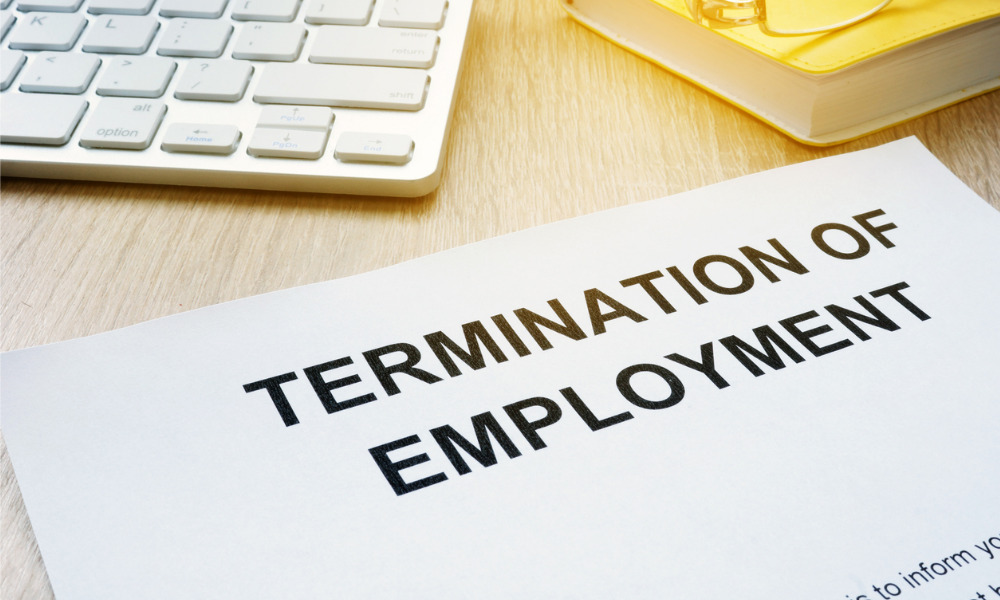
Do you have a solid termination clause in place?

Each termination is a different story for the people and organizations involved. As such, the act of dismissing a staff member should be looked at in a wider context of the employer’s legal liabilities. One of the things that employers are often wary of is the potential for a constructive dismissal claim.
“There’s so much in the area that clients need advice on,” said Gordana Ivanovic, employment lawyer from McMillan LLP. “That happens when an employer unilaterally changes some essential terms of the employment agreement, or if there’s been a course of conduct by that employer, which established that the employer no longer intends to be bound by the employment contract.”
In more recent times, instances in which employers decide to cut wages or work hours have become a hot-button issue. “Certainly this was a huge discussion early on in the pandemic, especially before any type of discussions were being had about assistance from the government,” Ivanovic said.
Read more: Laid off over COVID? You can’t claim constructive dismissal
“There was a lot of discussion about temporary layoffs and [whether] they could do that, but then there’s always that risk of having a potential constructive dismissal claim alleged against the employer. Or if they were changing the duties, wages or hours, that risk was prevalent again.”
When considering a termination, the employment agreement will remain the bedrock of all discussions going forward. “The first thing I ask about always is the employment agreement. Is there a written agreement? Was it an oral agreement? If it’s a written agreement, the main thing I’m interested in seeing is the termination provision. What does it say about how and when the employer can terminate their employee?
“If you don’t have a solid agreement in place with a really good termination clause, there’s a risk that the employer is going to have to pay or provide common law reasonable notice or common law pay in lieu of notice, which is considerably higher most of the time than what the Employment Standards Code will provide for the minimum,” the lawyer said.
“If there’s no written employment agreement or not a great termination provision, now we’re looking at the common law entitlements for that employee. If they are a long-term employee or are higher up, such as in a managerial role, the potential damages that the employer could face – if there’s a wrongful termination claim initiated against the employer for termination pay – could be quite considerable.”
Read more: Can you fire an employee for their social media posts?
For one, an employer can’t just provide staff members with a new contract with a different termination provision. “Again, you’re changing something fundamental to the initial agreement and you can’t do that without that risk of constructive dismissal claim,” Ivanovic said.
“What the employer needs to do – if they want to change the agreement and tighten up that termination provision – is that they’re going to have to provide consideration or something in exchange for executing a new agreement.”
Another factor to consider when letting go of an employee is whether the employee has recently been on any kind of medical leave or any type of statutory leave. “Those things pose a very delicate situation and you want to make sure those terminations are dealt with properly. Those are situations where employers can run into potential wrongful terminations in addition to potential human rights claims, which are situations we do not want to see employers find themselves in,” the lawyer said.
However, there are also terminations for cause. “When clients come to me and are proposing a termination for cause, we always have a very open and frank discussion about the risks involved and, like I said earlier, each case and each termination will be based on a very specific set of their own facts. So, that’s also an area that needs a good discussion.
“Essentially, what it comes down to is that every employer would like to have as clean a termination as possible and a termination that will pose the least amount of risk. It’s all really about a risk analysis when it comes to terminations. What we’re trying to do is minimize the risk that’s involved.”
To hear more from employment law experts, register for HRD Employment Law Masterclass here.